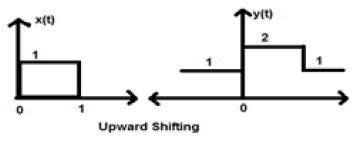Amplitude shifting means shifting of signal in the amplitude domain (around X-axis). Mathematically, it can be represented as −
This K value may be positive or negative. Accordingly, we have two types of amplitude shifting which are subsequently discussed below.
Case 1 (K > 0)
When K is greater than zero, the shifting of signal takes place towards up in the x-axis. Therefore, this type of shifting is known as upward shifting.
Example
Let us consider a signal x(t) which is given as;
Let we have taken K=+1 so new signal can be written as −
So, y(t) can finally be written as;

Case 2 (K < 0)
When K is less than zero shifting of signal takes place towards downward in the X- axis. Therefore, it is called downward shifting of the signal.
Example
Let us consider a signal x(t) which is given as;
Let we have taken K = -1 so new signal can be written as;
So, y(t) can finally be written as;

No comments:
Post a Comment